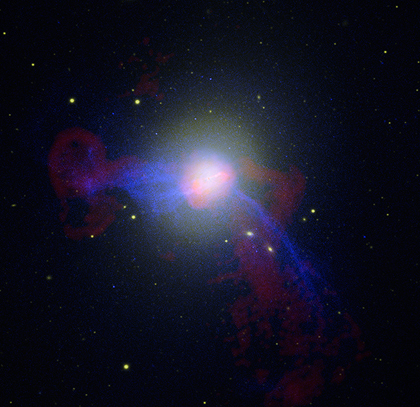Welcome to the Virgo Cluster
We recently featured a composite image of Chandra and Hubble data of the object known as M87. This object, which gets its name from being the 87th object in Charles Messier's catalog, is the giant elliptical galaxy in what is known as the Virgo Cluster. If you are interested in astronomy, you have probably heard of the Virgo Cluster. What makes this cluster of galaxies so important that it seems like astronomers use every type of telescope to study it?
The short answer is that, at a distance of about 50 million light years, it is the nearest galaxy cluster to Earth, and it contains a fascinating galaxy known as M87.

M87 is called a "dominant" galaxy, since it is the most massive and energetic object in the cluster. Over billions of years, M87 has grown by absorbing or cannibalizing other galaxies. It has an extent of one million light years or more, and contains trillions of stars, and much more mass in hot gas and dark matter. M87 also contains one of the most massive black holes known.
Galaxy clusters are the largest organized structures in the universe, and as such are important for understanding the evolution of matter in the universe. They contain three major components: stars, gas (most of it very hot), and dark matter, which account for roughly 3%, 12%, and 85% respectively of the total mass of the cluster. Observations with X-ray telescopes can map the distribution of hot gas and dark matter in the cluster, and help to understand how much of each component is present. This information in turn can give valuable insight into important issues such as the role of black holes in galaxy formation, and the nature of dark matter.
By measuring the speed of gas clouds with optical telescope in the central regions of M87, astronomers have concluded that a supermassive black hole of with a mass equivalent to three billion suns lurks there. Radio, optical and X-ray observations reveal evidence for a series of violent outbursts from this black hole. A series of unevenly spaced loops and bubbles visible in Chandra images indicate that small outbursts from close to the black hole occur about once every 6 million years.
The Virgo cluster of galaxies is an "irregular" cluster. This means that Virgo's more than 2000 members are scattered asymmetrically, and include a variety of different galaxy types. At 50 million light years away, Virgo is the closest major cluster and the center of our Local Supercluster. In fact, due to Virgo's immense mass, our Local Group of galaxies is affected by its gravity. Virgo's gravity is so strong that it pulls galaxies and groups of galaxies toward it. This effect is called the Virgo-Centric flow. Eventually, galaxies pulled toward Virgo may join the cluster.
Since it was launched in 1999, Chandra has observed M87 and the Virgo cluster many times. In addition to the recent image, take a look at previous releases:
2006 and 2004.
[Note, this entry was edited on 10/29/08]
Please note this is a moderated blog. No pornography, spam, profanity or discriminatory remarks are allowed. No personal attacks are allowed. Users should stay on topic to keep it relevant for the readers.
Read the privacy statement
